May 17, 2025 | 03:19 GMT +7
May 17, 2025 | 03:19 GMT +7
Hotline: 0913.378.918
May 17, 2025 | 03:19 GMT +7
Hotline: 0913.378.918
Cat Ba National Park (Hai Phong), established on March 31, 1986, is one of 33 national parks in the country and the first national park with both forests and sea. The national park has an area of more than 6,450 ha of sea surface and over 10,900 ha of land, along with 4,048 species of forest and marine animals and plants.
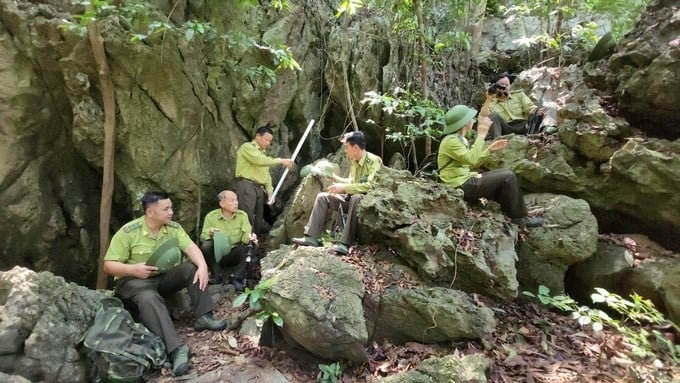
The terrain of Cat Ba National Park is very rugged and difficult to travel. Photo: Dinh Muoi.
Cat Ba National Park is a relatively complex area surrounded mainly by sea surface area and rugged limestone mountain terrain, causing many difficulties for forest rangers’ patrol work for violators.
According to statistics from the tourism industry, on average each year, more than 2 million tourists come to Cat Ba, bringing a total revenue of trillions of dongs. In 2022 alone, Cat Ba welcomes more than 2.3 million tourists, with a large number of people flocking to Cat Ba National Park.
Since the Cat Ba Archipelago was recognized as a World Biosphere Reserve, more and more tourists have come here. Recently, on average each year, about 2 million tourists visit Cat Ba, resulting in an increase in tourism services and making it difficult to conserve natural resources.
In addition to the work of forest protection, the Cat Ba National Park Forest Protection Department also performs the function of protecting the Cat Ba Archipelago World Biosphere Reserve, which has an area of over 26,000 ha. However, the ranger force here is relatively thin, with only 60 people and 12 ranger stations (of which there are 4 floating stations in the sea).
Mr. Nguyen Quang Khai, Chief of the Khoan Cao Ranger Station, shared that the ranger force also has a lot of daily work, with the main job of patrolling and protecting the forest. The patrol is very hard and difficult. Sometimes, with long patrol routes, forest rangers had to stay overnight in the forest.
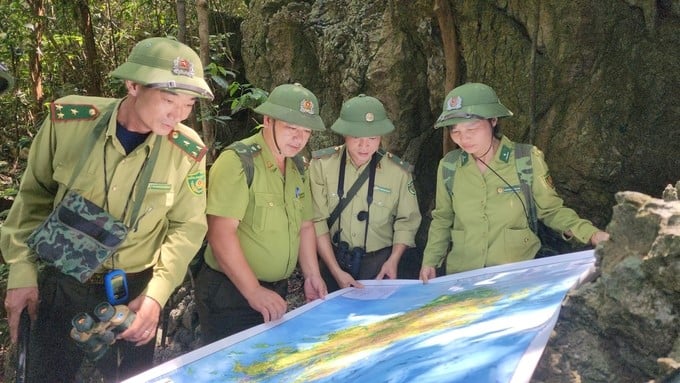
On long-day patrol trips, forest rangers have to sleep in the forest. Photo: Dinh Muoi.
In addition to disseminating the law on forest protection to people, forest rangers here also have to propagate it to tourists coming to Cat Ba National Park so that tourists can gain information and raise awareness about protecting the environment and not affecting the forest ecosystem.
"We face many difficulties in life, daily activities, and the work of forest patrol and protection, but we always try to fulfill our duties well. In addition to patrolling, we also have to grasp the situation and disseminate information on environmental protection to people and tourists so that production and tourism activities do not affect the current status of forest resources, contributing to improving the people's awareness of forest protection," said Mr. Khai.
Despite many difficulties, the tasks of conserving natural resources, conducting scientific research, and developing ecotourism services, as well as the work of forest protection in Cat Ba National Park, have always been maintained regularly over the years, with a progressively decreasing number of violations.
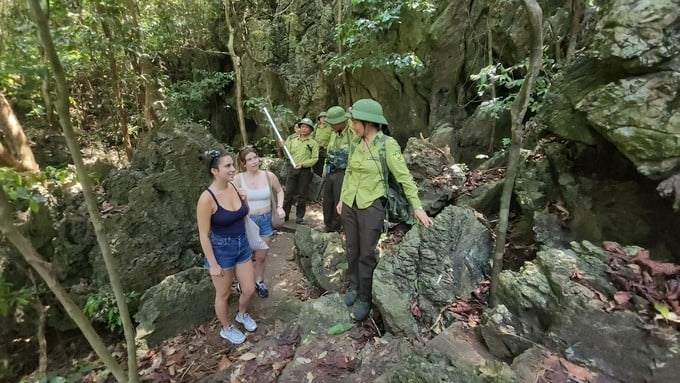
Forest rangers communicate, introduce, and guide foreign tourists to comply with regulations on forest protection. Photo: Dinh Muoi.
In order to meet the job requirements, in addition to expertise and profession, forest rangers in Cat Ba have to self-study foreign languages to be able to communicate with and guide foreign tourists in protecting the ecological environment when sightseeing in the national park.
"We have to do our own research and learn more foreign languages to disseminate the law to foreign tourists, guide the way around, and tell them to protect the environment and not to affect the natural landscape when visiting attractions of Cat Ba National Park," shared Mr. Do Van Dong, Eo Bua forest ranger.
Despite the thin force and many specific difficulties, in recent times, the work of forest fire prevention and control has always been a major concern; the number of forest fires has decreased gradually over the years. In recent years, there have been no big fires in Cat Ba, with mainly Imperata cylindrica fires and no damage to the forest.
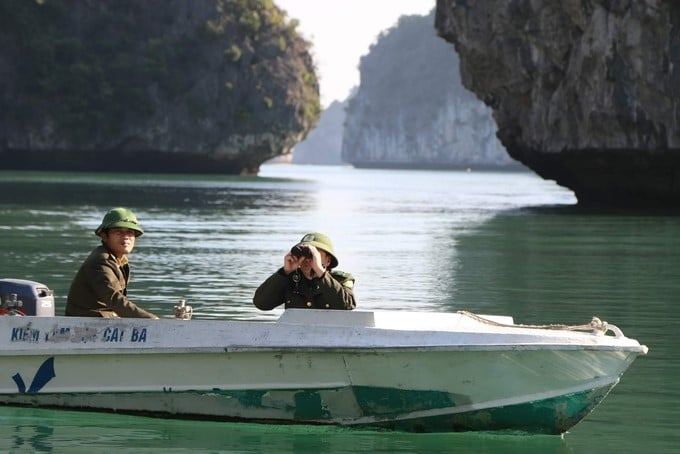
The ranger force in Cat Ba patrols the sea. Photo: Dinh Muoi.
The functional force has well controlled the bay, sea, and wetland areas and the households cultivating lagoons, lakes, and upland fields in the area, as well as participating in information dissemination on reducing aquaculture cages to clean up the environment.
On the other hand, the forest protection force has participated in training courses to improve their professional skills and use supporting tools and technological equipment in their working processes, such as GPS, digital maps, Smart software, etc. Along with that, they have also participated in many scientific research topics; maintained patrols and control of approximately1,300 turns/year; seized and destroyed thousands of forest animal traps of all kinds; arrested, coordinated, and promptly handled many law violations.
The ranger force has done a good job of coordinating with local authorities in the work of protecting forest and marine resources, as well as building forest protection groups and promulgating coordination regulations on inspection and control of forest and sea protection, fire prevention and fighting, natural disaster prevention and control, and search and rescue.
The forest protection force also strengthened cooperation and called for the participation of branches and the support of domestic and international organizations in the work of preserving and developing biodiversity resources in the Cat Ba Archipelago World Biosphere Reserve. At the same time, develop many communication materials to raise people's awareness about the conservation of natural resources, landscape, and environment in the island district.
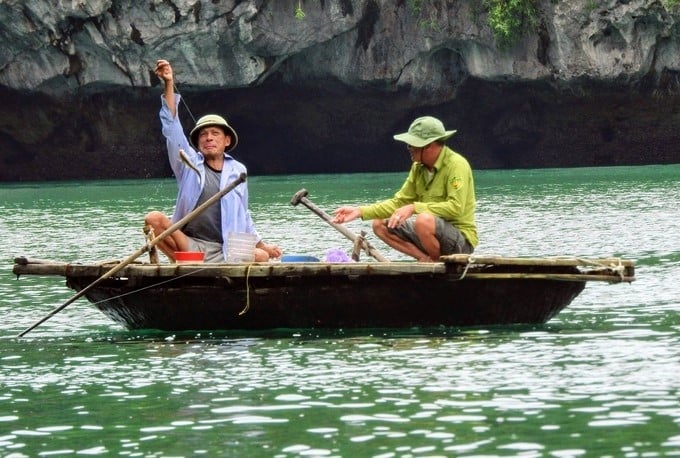
Sticking to and disseminating the law to people anytime, anywhere. Photo: Dinh Muoi.
Mr. Nguyen Van Thiu, Director of Cat Ba National Park, said that the park’s ranger force has 58 people, and despite many difficulties, they always promote their functions and duties in keeping the forest and sea, contributing a significant part to the protection and development of biodiversity for the Cat Ba Archipelago, and detecting and timely preventing all impacts on natural resources and biodiversity.
Currently, the management and protection of wild animals and plants and endangered and endemic species in Cat Ba National Park have been gradually restored. The people's awareness of natural resource protection has gradually improved. Particularly, the population of Cat Ba langur has a good growing tendency. With the help of the Cat Ba Langur Conservation Project, up until now, the langur population has increased in quantity to about 78 individuals.
In the past, many people lived in the forest, from logging, hunting, and slush-and-burn cultivation. Now, most working people have jobs and stable incomes thanks to participating in tourism, transportation, construction, and aquaculture services, so they do not enter the forest for illegal exploitation anymore.
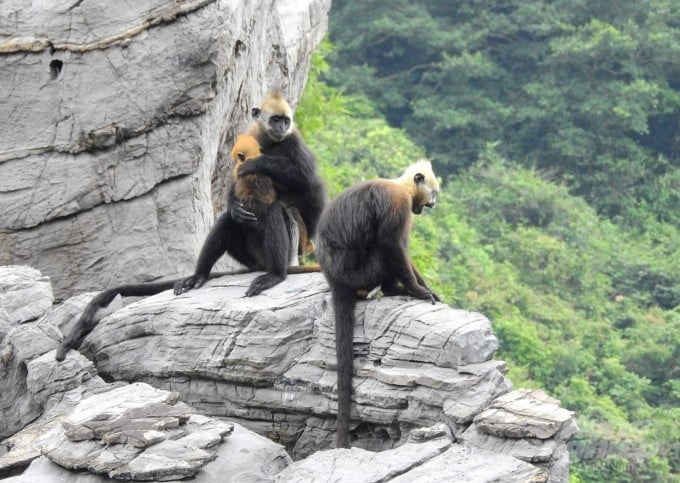
The herd of rare and precious langurs has grown and increased in quantity. Photo: Huy Cam.
That is a general achievement thanks to the locality’s socio-cultural-economic development programs, but in this achievement, there is a contribution from the ranger force in mobilizing people to settle agriculture, guiding people to increase production, change jobs, restore traditional occupations, develop tourism services, etc. to increase income and improve living standards.
"Despite the difficulties, we still tell each other that let's try to preserve the Cat Ba archipelago as a place of biodiversity, a place to preserve rare and precious genetic resources, and a place with the most beautiful Lan Ha Bay in the world; jointly preserve the value that nature bestows on people, especially for the Cat Ba people," said Mr. Thiu.
From 1996 to 2013, the Cat Ba National Park rangers handled 704 violations and confiscated 16 shotguns of all kinds. From 2013 to 2023, there were only 68 violations, along with the seizure, reception, and re-release of many individuals of wild animals and migratory birds.
Forests in Cat Ba have played a great role in preserving rare and precious plant and animal genetic resources, protecting the environment, and providing great scientific and economic value to the locality. It is the result of tireless efforts to manage, protect, and develop local forest resources over the years, with the contribution of many generations of Cat Ba National Park officials.
Translated by Huyen Vu Thu

(VAN) Cold-barn systems efficiently manage environmental and temperature conditions, which aids in the prevention of respiratory diseases in pigs and protects them from the vectors that transmit African swine fevers.

(VAN) To tackle challenges, the project 'Addressing key technical bottlenecks in the grouper supply chain in Vietnam' has been underway since 2024.

(VAN) The project 'Disease-Resilient and Sustainable Cassava Production Systems in the Mekong Region', funded by the Australian Center for International Agricultural Research (ACIAR), is being implemented from 2024 to 2028.

(VAN) Data from 10,000 farming households will help professionalize production organization and support the implementation of the One Million Hectares Program for High-Quality, Low-Emission Rice Cultivation.

(VAN) FAO Director-General QU Dongyu marks International Day of Plant Health at NENA conference.

(VAN) Deputy Minister of Agriculture and Environment Hoang Trung affirmed that floriculture and ornamental plants are a growing industry that receives significant global attention.

(VAN) The three staple crops dominating modern diets – corn, rice and wheat – are familiar to Americans. However, fourth place is held by a dark horse: cassava.